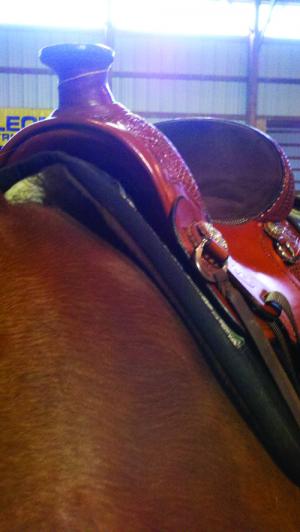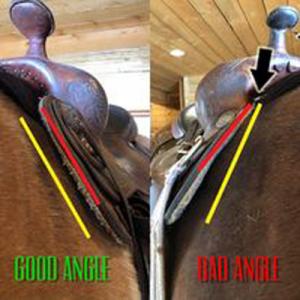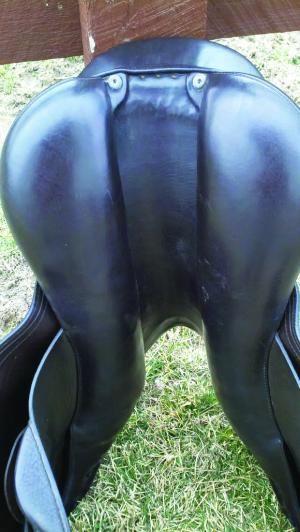Proper Prior Planning Prevents Poor Performance
By Terry Peiper, Fit Right Saddle Solutions
If you are planning for the show season, you have to schedule the shows you’re attending, train and condition the horses. If you are planning to trail ride and camp, you have to schedule the time off work, make reservations and get the camper ready. If you are competing in distance riding, you have to schedule the training/conditioning rides leading up to the competition. No matter what type of riding you do, you also have to plan to check your saddle fit.
The text book says to have the saddle checked professionally once a year, but I have seen some saddles go very wrong in a year, so I tell everyone 6-12 months. And every rider should be checking their own saddle fit every time they tack up. Horses change shape due to seasons, riding schedules, age, training/conditioning, so the saddle that fits today will not likely fit in 6, 12, or 24 months.
If you have an adjustable saddle, you should get it checked professionally every 6-12 months. Since you purchased a saddle that can continue to fit as the horse changes, it would be a shame not to take advantage of that benefit. If you have a saddle that is not adjustable, you might be able to improve the fit with flocking adjustments or a saddle pad. There are a lot of saddle pad options to try to improve saddle fit. But there are no saddle pads that can make a saddle fit, although marketing will try to tell us that it will. If your saddles are not adjustable, you might need to have a couple different saddles.
Some signs that your saddle doesn’t fit could be rubs, girth sores, white hairs, behavior issues like not standing to be mounted, hot headed or anxious, trouble with leads, lack of willingness to move forward, refusing jumps, unexplained lameness, the need for chiropractic care, not engaging the hindquarters, hollowing the back, not gaiting, head tossing, poor posture, or muscle atrophy.
Here is a basic saddle fit checklist for your horse. Place the saddle on the horse with no saddle pad. The horse needs to be standing on a reasonably level surface, standing as square as possible with the head straight and level to evaluate static fit.
1. Does the saddle sit level? An old trick is to put a pen or a piece of chalk on the seat and it should roll to the middle of the seat not the front or back. A downhill horse will need a rear balance seat for the horse and rider to line up and stay balanced with the rider’s center over the horse’s center. Saddles that are too wide are usually too low in the front. Saddles that are too narrow are usually too high in the front.
2. Does the saddle provide wither clearance? There has to be space between the saddle and the top of the withers. The rule is usually three fingers to allow for the movement of the horse, saddle pad and the compression that happens with the girth and rider’s weight.
3. Does the tree angle match the horse’s shoulder angle? This is absolutely critical so that the cartilage on the top of the shoulder is not damaged when it slides back under the front of the saddle. Pressure on the shoulders can cause the horse to shorten his stride, which then can cause damage to the front feet. Whether you are riding a gaited horse, a jumper, dressage, trail, timed events, western performance, or for pleasure, every horse needs to have shoulder freedom. The western horses performing in timed events need to have the maximum reach for quicker times. The dressage horse needs to be able to extend the trot and engage the hindquarters for lead changes, pirouettes, and lateral work. The reining horse needs to lift the shoulders for lead changes and sliding stops. The trail horse needs to carry a rider for several hours over varied terrain. The gaited horse needs to lift the shoulders and lower the haunches to have a true and smooth gait.
4. Are the billets or rigging in the right place? The billets of an English saddle and rigging on a western saddle need to fall into the girth grove. If they are not falling in the right place, there will be a constant conflict while you are riding between where the saddle wants to sit and where the billets/rigging want to pull it to. This constant conflict usually leads to girth sores.
5. Is the saddle the right length and balance for the horse’s back? The saddle support area is behind the shoulder along the top of the rib heads and ends at the front of the lumbar at the last rib. English saddles are shorter and can fit behind the shoulder and in front of the last rib. Western saddles are longer than the horse’s saddle support area, so the tree flares in the front over the shoulder and the rear to keep most of the rider’s weight behind the shoulder and in front of the last rib. A saddle that is too long can trigger a bucking reflex. Too much weight on the lumbar can cause a horse to be off or lame in the hind end.
6. Is the channel of the saddle wide enough to keep the pressure off of the spinal ligament? Most horses have a spinal ligament 4-5 fingers wide. The panels or bars need to be wide enough to distribute the rider’s weight along the top of the ribs on both sides while protecting the spinal ligament from pressure. The horse’s spine needs to sway as the horse moves and bend while going around turns. A saddle that is pinching the spinal ligament will cause the horse to hollow the back and lift the head. When the spinal ligament is free from pressure, the horse will want to stretch down and forward because it is natural and comfortable to be in that position.
7. Does the arc of the tree or panels match the arc of the horse’s back? A saddle that is not touching the horse in the middle under the rider’s leg is bridging. When a saddle is bridging, all the pressure is in the front and back. The saddle should distribute the rider’s weight almost evenly. Ideally there would be 30% to the front, 40% in the middle where the horse is the strongest, and 30% to the rear. The opposite of bridging is rocking. A saddle that rocks usually causes rubs and white hairs in the middle of the horse’s back.
Saddle Fit Check List
Have someone video you riding or take some pictures of you on your horse standing on a reasonably level surface, and also while walking, trotting, or gaiting.
1. Does the seat fit? For an English saddle, the flap should frame the rider’s leg. There should be room for your hand behind your seat in front of the cantle. The flap should be a few inches below the top of your boot. For a western rider, you should have 2-4 fingers in front of your leg behind the pommel. The rider should be able to stand in the stirrups.
2. Do you have hip, knee, or back pain after riding? The hip, knee, and ankle joints are the shock absorbers. What is not absorbed in the joints is absorbed in the lower back. The saddle must allow the rider to have the natural curve in their back to absorb the shock, just like when we walk. Saddle seats that are too wide can also cause hip and back pain and painful torque on the knees.
3. Does the saddle cause rubs? The seat must be supportive yet comfortable. It is common for riders to think of their horse’s comfort first, but the saddle must work for both horse and rider. A rider that is compensating for an uncomfortable seat will cause uneven pressure on the horse’s back.
4. Are you having trouble with balance and poor leg position? The saddle should allow the rider to be in the shoulder-hip-heel-aligned position with their center over the horse’s center. Just like we walk around, shoulder, hip, heel are aligned. Whether the rider is jumping with very short stirrups or trail riding with long stirrups, we must have our feet under us or we are off balance.
5. Are the stirrup bars or fenders in the right place? The stirrups are there to take the weight of the leg off the hip joints, but they must be attached to the saddle in the right place for the rider’s leg. The length of the rider’s femur will determine how far forward or back the stirrups need to hang so the rider can be balanced.
How the saddle fits will affect our horse’s behavior, performance and ultimately the health of horse and rider. Make checking your saddle fit a part of your tacking up routine. Proper prior planning can ensure a happy comfy ride for horse and rider. Find more information about proper saddle fit and Terry’s saddle fit clinics at: https://www.fitrightsaddlesolutions.com/
By Terry Peiper, Fit Right Saddle Solutions
If you are planning for the show season, you have to schedule the shows you’re attending, train and condition the horses. If you are planning to trail ride and camp, you have to schedule the time off work, make reservations and get the camper ready. If you are competing in distance riding, you have to schedule the training/conditioning rides leading up to the competition. No matter what type of riding you do, you also have to plan to check your saddle fit.
The text book says to have the saddle checked professionally once a year, but I have seen some saddles go very wrong in a year, so I tell everyone 6-12 months. And every rider should be checking their own saddle fit every time they tack up. Horses change shape due to seasons, riding schedules, age, training/conditioning, so the saddle that fits today will not likely fit in 6, 12, or 24 months.
If you have an adjustable saddle, you should get it checked professionally every 6-12 months. Since you purchased a saddle that can continue to fit as the horse changes, it would be a shame not to take advantage of that benefit. If you have a saddle that is not adjustable, you might be able to improve the fit with flocking adjustments or a saddle pad. There are a lot of saddle pad options to try to improve saddle fit. But there are no saddle pads that can make a saddle fit, although marketing will try to tell us that it will. If your saddles are not adjustable, you might need to have a couple different saddles.
Some signs that your saddle doesn’t fit could be rubs, girth sores, white hairs, behavior issues like not standing to be mounted, hot headed or anxious, trouble with leads, lack of willingness to move forward, refusing jumps, unexplained lameness, the need for chiropractic care, not engaging the hindquarters, hollowing the back, not gaiting, head tossing, poor posture, or muscle atrophy.
Here is a basic saddle fit checklist for your horse. Place the saddle on the horse with no saddle pad. The horse needs to be standing on a reasonably level surface, standing as square as possible with the head straight and level to evaluate static fit.
1. Does the saddle sit level? An old trick is to put a pen or a piece of chalk on the seat and it should roll to the middle of the seat not the front or back. A downhill horse will need a rear balance seat for the horse and rider to line up and stay balanced with the rider’s center over the horse’s center. Saddles that are too wide are usually too low in the front. Saddles that are too narrow are usually too high in the front.
2. Does the saddle provide wither clearance? There has to be space between the saddle and the top of the withers. The rule is usually three fingers to allow for the movement of the horse, saddle pad and the compression that happens with the girth and rider’s weight.
3. Does the tree angle match the horse’s shoulder angle? This is absolutely critical so that the cartilage on the top of the shoulder is not damaged when it slides back under the front of the saddle. Pressure on the shoulders can cause the horse to shorten his stride, which then can cause damage to the front feet. Whether you are riding a gaited horse, a jumper, dressage, trail, timed events, western performance, or for pleasure, every horse needs to have shoulder freedom. The western horses performing in timed events need to have the maximum reach for quicker times. The dressage horse needs to be able to extend the trot and engage the hindquarters for lead changes, pirouettes, and lateral work. The reining horse needs to lift the shoulders for lead changes and sliding stops. The trail horse needs to carry a rider for several hours over varied terrain. The gaited horse needs to lift the shoulders and lower the haunches to have a true and smooth gait.
4. Are the billets or rigging in the right place? The billets of an English saddle and rigging on a western saddle need to fall into the girth grove. If they are not falling in the right place, there will be a constant conflict while you are riding between where the saddle wants to sit and where the billets/rigging want to pull it to. This constant conflict usually leads to girth sores.
5. Is the saddle the right length and balance for the horse’s back? The saddle support area is behind the shoulder along the top of the rib heads and ends at the front of the lumbar at the last rib. English saddles are shorter and can fit behind the shoulder and in front of the last rib. Western saddles are longer than the horse’s saddle support area, so the tree flares in the front over the shoulder and the rear to keep most of the rider’s weight behind the shoulder and in front of the last rib. A saddle that is too long can trigger a bucking reflex. Too much weight on the lumbar can cause a horse to be off or lame in the hind end.
6. Is the channel of the saddle wide enough to keep the pressure off of the spinal ligament? Most horses have a spinal ligament 4-5 fingers wide. The panels or bars need to be wide enough to distribute the rider’s weight along the top of the ribs on both sides while protecting the spinal ligament from pressure. The horse’s spine needs to sway as the horse moves and bend while going around turns. A saddle that is pinching the spinal ligament will cause the horse to hollow the back and lift the head. When the spinal ligament is free from pressure, the horse will want to stretch down and forward because it is natural and comfortable to be in that position.
7. Does the arc of the tree or panels match the arc of the horse’s back? A saddle that is not touching the horse in the middle under the rider’s leg is bridging. When a saddle is bridging, all the pressure is in the front and back. The saddle should distribute the rider’s weight almost evenly. Ideally there would be 30% to the front, 40% in the middle where the horse is the strongest, and 30% to the rear. The opposite of bridging is rocking. A saddle that rocks usually causes rubs and white hairs in the middle of the horse’s back.
Saddle Fit Check List
Have someone video you riding or take some pictures of you on your horse standing on a reasonably level surface, and also while walking, trotting, or gaiting.
1. Does the seat fit? For an English saddle, the flap should frame the rider’s leg. There should be room for your hand behind your seat in front of the cantle. The flap should be a few inches below the top of your boot. For a western rider, you should have 2-4 fingers in front of your leg behind the pommel. The rider should be able to stand in the stirrups.
2. Do you have hip, knee, or back pain after riding? The hip, knee, and ankle joints are the shock absorbers. What is not absorbed in the joints is absorbed in the lower back. The saddle must allow the rider to have the natural curve in their back to absorb the shock, just like when we walk. Saddle seats that are too wide can also cause hip and back pain and painful torque on the knees.
3. Does the saddle cause rubs? The seat must be supportive yet comfortable. It is common for riders to think of their horse’s comfort first, but the saddle must work for both horse and rider. A rider that is compensating for an uncomfortable seat will cause uneven pressure on the horse’s back.
4. Are you having trouble with balance and poor leg position? The saddle should allow the rider to be in the shoulder-hip-heel-aligned position with their center over the horse’s center. Just like we walk around, shoulder, hip, heel are aligned. Whether the rider is jumping with very short stirrups or trail riding with long stirrups, we must have our feet under us or we are off balance.
5. Are the stirrup bars or fenders in the right place? The stirrups are there to take the weight of the leg off the hip joints, but they must be attached to the saddle in the right place for the rider’s leg. The length of the rider’s femur will determine how far forward or back the stirrups need to hang so the rider can be balanced.
How the saddle fits will affect our horse’s behavior, performance and ultimately the health of horse and rider. Make checking your saddle fit a part of your tacking up routine. Proper prior planning can ensure a happy comfy ride for horse and rider. Find more information about proper saddle fit and Terry’s saddle fit clinics at: https://www.fitrightsaddlesolutions.com/










